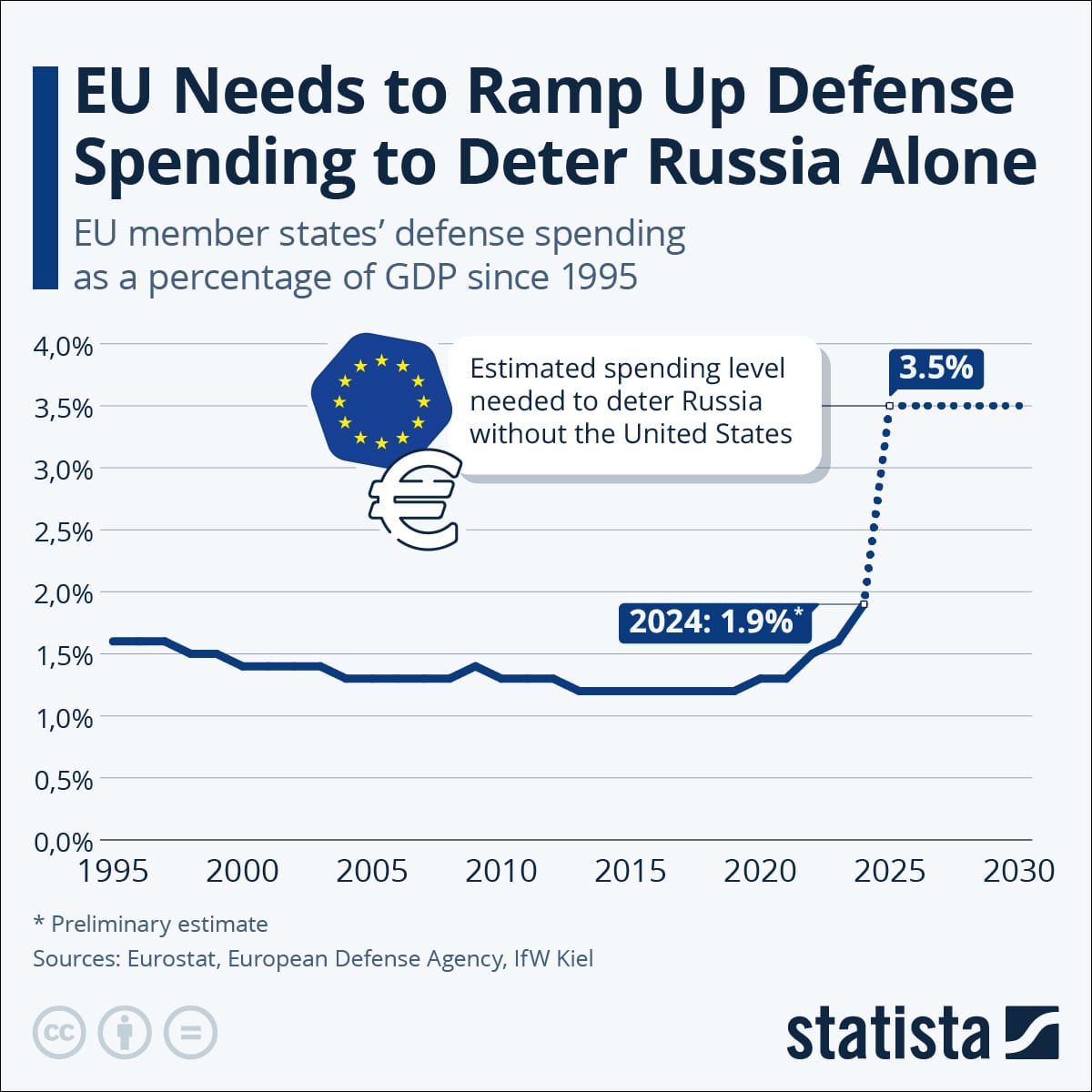
ReArm Europe: The EU’s €800-billion defense plan
After a fraught White House meeting, European leaders reaffirmed support for Ukraine, planning €800bn (£670m) in defence spending. The EU’s “ReArm Europe” plan reduces U.S. dependency, bolstering security and economic resilience.
The meeting and the White House’s subsequent decision to halt military aid to Ukraine have made clear to Europeans that they can no longer fully rely on the United States when it comes to deterring Russia and helping Ukraine defend itself against the Russian invasion.
Replacing U.S. military aid to Ukraine in case the U.S. decided to withdraw its support permanently would be the easier of the two tasks. According to first estimates from researchers at the Kiel Institute for the World Economy, the EU would only need to spend another 0.12% of its GDP annually to replace U.S. military contributions, which have added up to €64 billion (£53.5m) over the past three years. Permanently protecting Ukraine and deterring Russia would require significantly higher financial commitments, the authors find. According to the estimates, Europe would have to raise around €250 billion (£210m) in additional military spending annually, which would bring its joint defense spending from just under 2% of GDP to around 3.5% of GDP per year.
“In economic terms, this is manageable in relation to the EU’s economic strength, with the additional costs only amounting to around 1.5% of the EU's gross domestic product,” Professor Guntram Wolff, co-author of the analysis and Senior-Fellow at the Kiel Institute for the World Economy, said. “That is far less than had to be mobilized to overcome the crisis during the COVID pandemic, for example.” The additional spending requirements could even bolster the European economy, Wolff finds. “A debt-financed increase in defense spending could also act as an economic stimulus if it is spent within the EU, especially in times of declining external demand due to US tariffs and trade conflicts.”
 // CREDIT: STATISTA // CREDIT: STATISTA |
As our chart based on historical data from Eurostat and recent estimates from the European Defence Agency shows, the required spending level would be a significant step up from the EU’s usual defense spending, which has been hovering around 1.5% of GDP for large parts of the past three decades.
Ahead of Thursday’s European Council’s special summit, where EU leaders discussed the future of European defense and their continued support for Ukraine, Ursula von der Leyen, president of the European Commission, outlined a five-point plan to strengthen European defense and reduce the dependency on the United States.
At the heart of the plan called “ReArm Europe” is a provision that would allow member states to increase defense spending significantly without triggering the Excessive Deficit Procedure (EDP) outlined in the EU’s Stability and Growth Pact. The purpose of the pact outlined in 1997 was to ensure and enforce fiscal discipline within the EU by requiring each member state to stay within certain limits of government debt (60% of GDP) and deficit (3% of GDP). By making an exemption for additional defense spending, the European Commission aims to create up to €650 billion (£545m) in additional fiscal space over the next four years, assuming that member states increase their defense spending by 1.5% of GDP on average.
Secondly, the EU will provide €150 billion (£125.5m) in loans to member states for defense investments, aiming to exercise a certain control over these investments and better coordinate them. This joint procurement approach is expected to reduce costs and fragmentation, increase interoperability and strengthen Europe’s defense industry. The other proposals in the ReArm Europe plan include using the EU budget to direct more funds towards defense investments, for example, by creating incentives for member states to do so.
 // CREDIT: STATISTA // CREDIT: STATISTA |
Finally, the European Commission’s proposal aims to mobilize private capital by accelerating the Savings and Investment Union and utilizing the European Investment Bank. In total, the package could mobilize up to €800 billion (£670m) for “a safe and resilient Europe,” von der Leyen said, before concluding that “Europe is ready to step up.”

GOING FURTHER
EU chief unveils €800bn plan to ‘rearm’ Europe | THE GUARDIAN
‘Watershed moment’: EU leaders agree plan for huge rise in defence spending | THE GUARDIAN





[Read our Comments Guidelines]